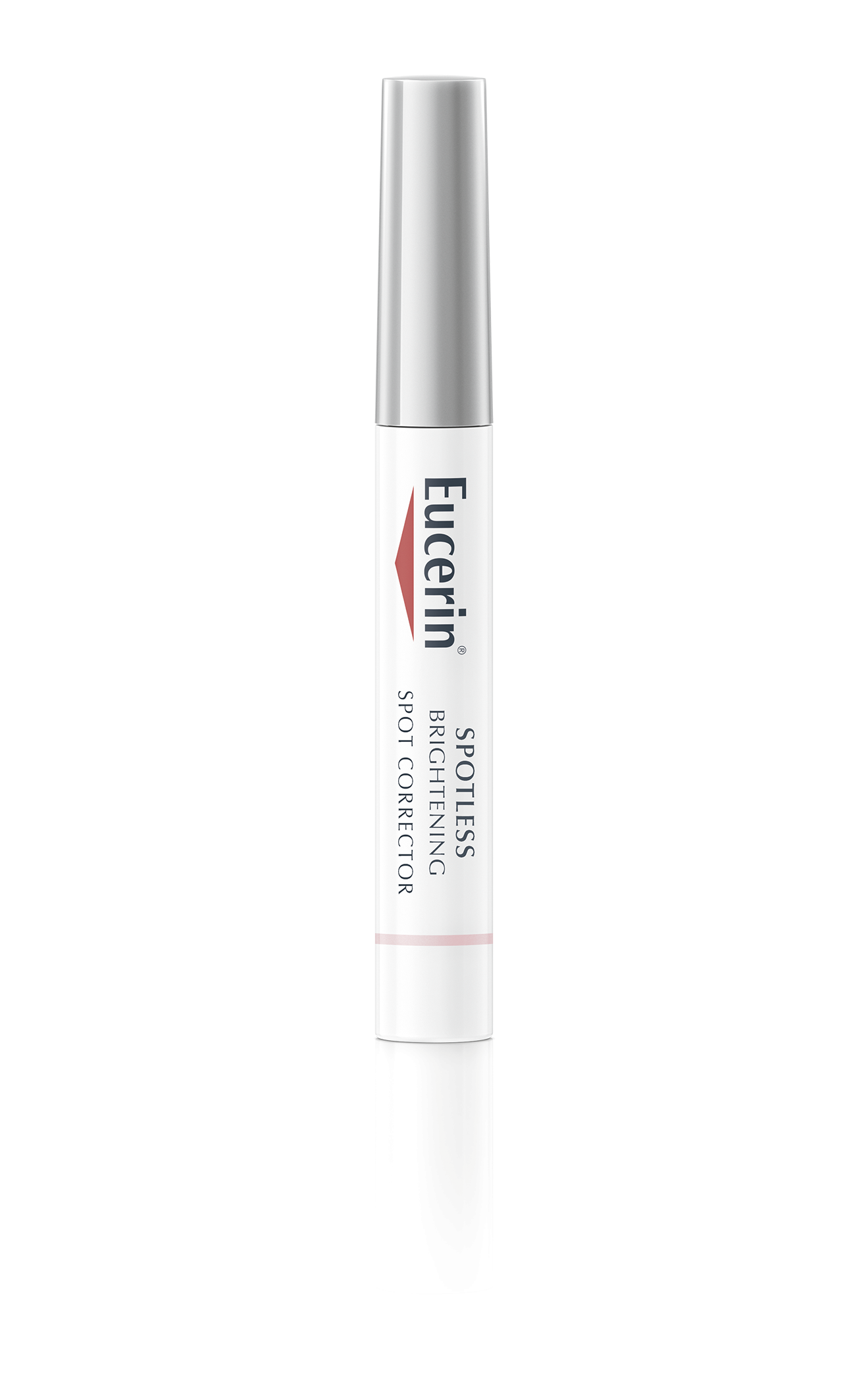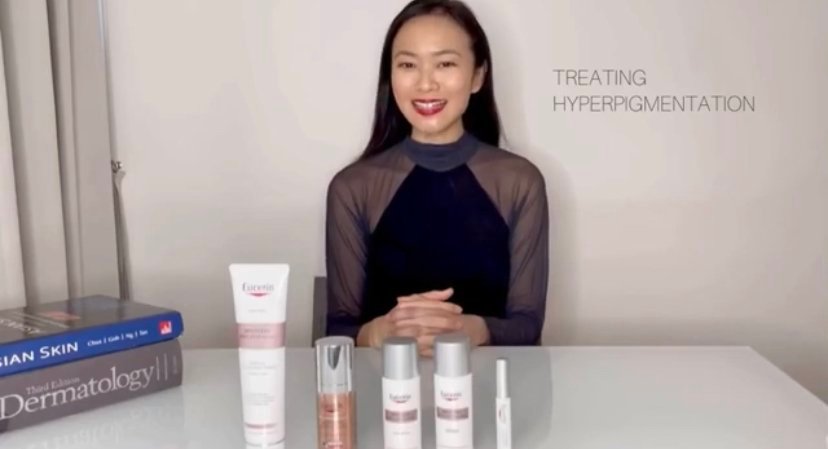Dr. Teo Wan Lin is an accredited dermatologist practising at TWL Specialist Skin and Laser Centre in Singapore. She has collaborated with Eucerin for this educational article and digital skincare masterclass episode. In this episode, she discusses the different types of dermatologist treatment for hyperpigmentation, including the importance of not just the effectiveness of an active ingredients, but also the tolerability.
She elaborates on the relevance of Thiamidol as an active cosmeceutical for hyperpigmentation treatment in EP 54: Thiamidol Lightens Pigmentation Without Laser Treatment on her podcast Dermatologist Talks: Science of Beauty, available on Spotify, Apple and Google podcasts.
Hyperpigmentation is a common concern of both men and women, and can be due to different underlying causes. From melasma, in which hormones can act as a trigger, to age spots/sunspots or solar lentigo, and post-inflammation hyperpigmentation. It is a form of scarring which can be due to previous acne scars or facial eczema.

Active cosmeceuticals for hyperpigmentation
There are some exciting new active ingredients that are effective in the treatment of these pigmentation concerns. Thiamidol is one of them. Thiamidol is a tyrosinase inhibitor, which means it blocks an enzyme called tyrosinase. In fact, it is the most potent blocker of tyrosinase out of 50,000 compounds they did tests on.
Why is tyrosinase relevant here? Tyrosinase is an important enzyme in the process of pigment formation. This process refers to melanogenesis, the main culprit for the formation of these pigmentation disorders we see in clinical practice.
How would a dermatologist treat hyperpigmentation?
Facial hyperpigmentation is not just a cosmetic concern, but it also can have rather debilitating psychosocial consequences for individuals who suffer from it. In Dr. Teo’s practice she uses a combination of prescription retinoids, hydroquinone and laser therapy. This is in combination with chemical peels to treat various sorts of hyperpigmentation. The reason why the treatment consists of combination is because some of these prescription cosmeceuticals often have irritation and side effects. Therefore, it is important to use them in moderation, and under medical supervision.
Research in the effectiveness of Thiamidol
The ingredient Thiamidol was first published in a clinical double-blind controlled split-face study in the International Journal of Cosmetic Science in August 2020. It is exciting to see the results of this study, not just in terms of its effectiveness, but also how tolerable it is.
Tolerability
Special emphasis is put on tolerability because even if you do not have sensitive skin, a lot of prescription cosmeceuticals and even nonprescription cosmeceuticals – because of its ability to alter certain functions in your skin, which is also responsible for its effectiveness – also carries with it the risk of skin irritation. For example, the last thing we want is to end up having a new problem as a side effect of treatment.
This split face study was performed via a double-blind randomized controlled clinical trial. This was in the form of two Thiamidol-containing products – a serum as well as an SPF 30 daycare product. Subjects were applying the serum twice a day on one-half of the face. The daycare application of SPF 30 was twice daily on the entire face.
The results of the study show improvement of mild to moderate facial hyperpigmentation in the subjects. This is after application of the product over 12 weeks and there was both objective and subjective assessment of the hyperpigmentation. The underlying skin condition, what we call a modified MASI score, is a dermatologist’s objective measurement of hyperpigmentation, as well as instruments that measure the improvements with a chromameter and clinical photography.
The results show that there was a statistically significant improvement in all the evaluated parameters when compared with the baseline, and previous visits in this study involved 34 subjects. Besides, there was a good assessment in terms of the tolerability as well as the cosmetic acceptability of the product.
Why is this study so important?
Traditionally, prescription treatments for hyperpigmentation include retinoids and hydroquinone. We usually associate these with a relatively high incidence of skin-redness flaking and sensitivity, which persist even after discontinuing use. This is sometimes independent of whether the individual had pre-existing sensitive skin.
Thiamidol vs other pigmentation lightening ingredients
We widely consider Thiamidol to be superior to other types of tyrosinase inhibitors. We have heard of Kojic acid, arbutin, or the prescription item hydroquinone. These ingredients are well known in terms of their effect on reversing melanin production when tested in cell cultures.
In addition, there is no risk of any accidental conversion to any toxic substances. This can sometimes be a problem with other types of tyrosinase inhibitors. Potentially irreversible, the condition leucoderma, can arise from adverse effects of using quinone substances.
How effective is thiamidol in treating hyperpigmentation?

Besides, thiamidol was effective not just in patients who have melasma, which is what most of the studies for hydroquinone have been for. It was also effective for other types of hyperpigmentation such as post inflammation hyperpigmentation from acne.
There was an interesting result noted in this study by the research group. It included clinical photography that was clearly demonstrating visible improvement of the hyperpigmentation, and also skin roughness. This is an important cosmetic effect that many users of skincare are looking for. Furthermore, it is absent in prescription tyrosinase inhibitors like hydroquinone. Most importantly, there was no statistically significant change in the baseline, redness, swelling dryness, or any uncomfortable sensation such as burning stinging or itching.
Summing up
Overall, this is potentially the best dermatologist treatment for hyperpigmentation. The focus on hyperpigmentation treatment has to be understood in the context of the underlying cause of the hyperpigmentation, which can be diagnosed properly by a dermatologist through additional measures of skin texture improvement and factors such as radiance and smoothness.
The key factor here is this thiamidol-containing product actually improved all the markers of these symptoms. Additionally, they did not confirm this just by photography chronometry, but also individual subjective assessments. This is because at the end of the day, patients are much more likely to apply a product that feels comfortable on their skin and also has additional benefits such as reducing the roughness of the skin and improving overall skin radiance.
This masterclass episode is sponsored by Eucerin as a joint collaboration to create scientific educational content relevant to skincare and dermatology. Images produced as part of editorial collaboration consistent with site policy.

